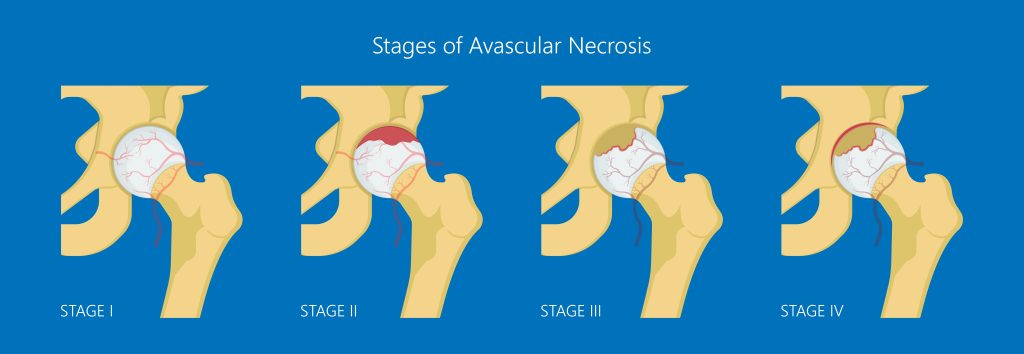Imagine a scenario where the very bones that support your body’s structure and facilitate your every movement start deteriorating silently, leaving you in excruciating pain and impairing your mobility. Unfortunately, this is the harsh reality faced by those who suffer from avascular necrosis. This condition stealthily attacks the bones and joints, causing irreparable damage. But fear not, for in this article, we will delve into the depths of avascular necrosis, unravelling its enigma and shedding light on its symptoms, causes, and treatment options.
What is Avascular Necrosis?
Avascular necrosis, also known as osteonecrosis, is a condition that affects the bones and joints, caused by a disruption in blood flow. The lack of blood supply leads to the death of bone tissue, resulting in pain, limited mobility, and potential joint damage. Avascular necrosis can affect joints such as the hips, knees, shoulders, and ankles. Therefore, understanding the symptoms of this condition is essential for early detection and effective management.
Symptoms of Avascular Necrosis
The symptoms of avascular necrosis can vary depending on the affected joint. However, there are common signs that individuals may experience. Joint pain and stiffness are some of the most prominent symptoms. This pain may worsen with weight-bearing activities and can restrict movement. One may experience limited range of motion and difficulty walking. Due to joint pain and stiffness, individuals may find it challenging to perform everyday tasks.
In the case of hip avascular necrosis, the pain might be felt in the groin area and can radiate to the buttocks or thighs. This can cause difficulty in walking or even standing for prolonged periods. Knee avascular necrosis may result in swelling and pain in the knee joint, making it challenging to bend or straighten the leg fully. Shoulder avascular necrosis can cause pain during arm movement and may limit the ability to lift objects. Ankle avascular necrosis can lead to pain, tenderness, and difficulty bearing weight on the affected foot.
Causes of Avascular Necrosis
Avascular necrosis can occur due to various factors. One of the primary causes is an injury, such as a fracture or dislocation, which disrupts the blood supply to the bone. Diseases like sickle cell anaemia, lupus, and HIV/AIDS can also increase the risk of avascular necrosis by affecting blood circulation or causing inflammation. Additionally, certain medications, such as corticosteroids, can contribute to the development of avascular necrosis by interfering with blood flow to the bones.
Excessive alcohol consumption is another significant risk factor for avascular necrosis. Prolonged alcohol abuse can weaken bones and decrease blood flow, increasing the chances of developing this condition. Other risk factors include smoking, radiation therapy, and certain medical conditions that require organ transplantation.
Diagnosis of Avascular Necrosis
Diagnosing avascular necrosis involves a combination of medical history, physical examination, and diagnostic tests. First, the doctor will inquire about the symptoms experienced, medical history, and potential risk factors. Physical examination may involve assessing joint mobility, tenderness, and signs of inflammation.
Imaging tests play a crucial role in the diagnosis of avascular necrosis. X-rays can help detect bone structure changes and reveal bone damage areas. However, the early stages of avascular necrosis may not be visible on X-rays. The health provider may recommend advanced imaging techniques like MRI or CT scans. These tests provide detailed images of the affected area and can help determine the extent of bone damage.
Blood tests might also be conducted to rule out other underlying medical conditions that mimic avascular necrosis symptoms. These tests can help assess overall health and identify any underlying factors contributing to the condition.
Treatment of Avascular Necrosis
The treatment approach for avascular necrosis depends on multiple factors, including the affected joint, the stage of the disease, and the underlying cause. Early detection is crucial as it offers the best chances for successful treatment.
Non-surgical treatment options may be recommended for individuals in the early stages of avascular necrosis or those with mild symptoms. Medications can also help alleviate pain and reduce inflammation.
Physical therapy aims to improve joint function, reduce pain, and increase mobility. Therapeutic exercises and stretches can help strengthen the surrounding muscles, supporting the affected joint. In addition, assistive devices, such as crutches or canes, may be recommended to reduce pressure on the joint during weight-bearing activities.
Surgical intervention may be required in advanced stages or cases where non-surgical treatments fail to provide relief. Joint-preserving surgeries, such as core decompression or bone grafting, aim to improve blood supply and prevent further bone damage. In a few severe cases, joint replacement may be required to replace the damaged joint with a prosthetic one.
Lifestyle Changes and Self-Care for Avascular Necrosis
In addition to medical treatments, lifestyle changes, and self-care measures can help manage avascular necrosis and improve overall health. Maintaining a healthy weight is crucial, as excess weight can stress the affected joints. In addition, following a balanced diet that includes adequate nutrients for bone health, such as calcium and vitamin D, is essential.
Avoiding alcohol and smoking is highly recommended, as they can exacerbate the condition and hinder healing. Under a healthcare professional’s guidance, regular exercise can help strengthen muscles, maintain joint flexibility, and improve overall well-being. Low-impact activities like cycling or swimming are often recommended to minimize joint stress.
Conclusion
Avascular necrosis is a condition that can significantly impact an individual’s quality of life. Understanding the symptoms, causes, and treatment options is crucial for early detection and effective management. Timely medical intervention, lifestyle changes, and self-care measures can help control pain, improve functionality, and prevent the bones from further damage. If you experience persistent joint pain, stiffness, or difficulty in movement, it is essential to consult a healthcare professional.
References:
https://my.clevelandclinic.org/health/diseases/14205-avascular-necrosis-osteonecrosis
https://www.hopkinsmedicine.org/health/conditions-and-diseases/avascular-necrosis
https://www.niams.nih.gov/health-topics/osteonecrosis
https://www.mayoclinic.org/diseases-conditions/avascular-necrosis/symptoms-causes/syc-20369859
https://emedicine.medscape.com/article/333364-treatment
https://www.healthline.com/health/avascular-necrosis-osteonecrosis





Comments are closed.